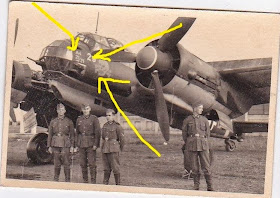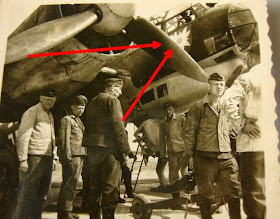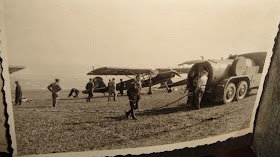Thursday, 31 October 2013
Daily Luftwaffe Ebay photo find- 11.(N)/JG 2 Me 109 Dora, Fw 190 Tarnmuster, Battle of Britain Stukas
Unique camo scheme on this early variant Fw 190 and still three days left to bid.
http://www.ebay.de/itm/org-Foto-Wehrmacht-Flugzeug-Jagdflugzeug-Focke-Wulf-Fw-190-Wuerger-Tarnmuster-/310782061561?&maxbid=15%2C00&autorefresh=true
According to the seller this is a Me 109 of 2./JG 77 in Italy or Africa but as this appears to be an early Emil that appears unlikely. Note the eagle head Staffelwappen. Still two days to bid here
Compare the above image with this shot from Jean-Louis Roba's "Les As de la Chasse de jour Allemande" ( German fighter aces ) published by ETAI which is a large French-language 'coffee-table' picture book of German fighter pilots. Uffz. Heinrich Brunsmann was briefly a fighter pilot (..although not an ace!) with 5./ JG 77 and is here seen in Scandinavia during August 1940. Brunsmann left JG 77 in April 1941 and survived the war.
This seller appears to deal in mostly well-known repros but there are one or two items of interest in his current sale offers.
http://www.ebay.de/itm/FOTO-WK-2-MESSERSCHMITT-Me110-Me-110-Bf110-Bf-110-CAMO-TARN-/221307942464?ssPageName=ADME:B:SS:GB:1120
http://www.ebay.de/itm/Foto-Flugzeug-Me-109-gelbe-14-Staffelwappen-Feldflugplatz-Norwegen-1940-/141103507425?ssPageName=ADME:B:SS:GB:1120
Above;
Night fighting with Bf 109s was not the invention of Hajo Herrmann and JG 300 in 1943. One early Bf 109 night fighting unit was IV.(N)/JG 2 which was established in February 1940 and had its origins in the Arado 68-equipped 10.(N)/JG 131. Its component Staffeln assumed responsibility for the defence of the German Bight coastline under the operational command of the Stab/JG1. Maj. Albert Blumensaat was Gruppenkommandeur of IV.(N)/ JG 2 from February to June 1940 when the unit was incorporated into NJG 1. He was previously Staffelkapitän of 10.(N) /JG 2 prior to being appointed Gkr. He was replaced in this command by Oblt. Erwin Bacsila who later achieved a degree of notoriety with Sturmstaffel 1. The Staffelkapitän of 11.(N)/ JG2 was a certain Johannes Steinhoff while the StaKa of 12(N)./JG 2 was Oblt. Hans Baer. 'N+7' above was probably the a/c of Ofw. Hermann Förster of 11.(N)/JG 2 who claimed his first victory on 22 Feb 1940 (a Wellington -note the two tail kill markings). His second victory on 26 April 1940 was a 49 Sq Hampden shot down on a mine-laying sortie near Hörnum. On 23 April 1940 12. and 11.(N)/JG2 Bf 109D fighters had moved from Jever via Aalborg to Trondheim (Norway) to support other fighter units in that theatre. 11.(N)/JG2 Bf 109 D machines usually display the unit's Eulenwappen (owl emblem) on the forward fuselage just above the exhaust as here..
http://www.ebay.de/itm/FOTO-FLUGZEUG-ME-109-TARN-KENNUNG-N-7-STAFFELZEICHEN-R-FELDFLUGPLATZ-/111202206192?ssPageName=ADME:B:SS:GB:1120
Battle of Britain period Ju 87 Stukas from Michael Meyer including a rare formation takeoff of II./ StG 77 machines during August 1940. A few of these would have been an excellent addition to Andy Saunders recent Stukas tome. Below, Ju 87 B of II./StG 77 being refuelled at Evrecy le Petit during June 1940.
Ju 87 B of 4. StG 77 with SC 500 KG Bombe, location is given as Bouchy near Evrecy during August 1940...
Start gegen England! Ju 87 Bs of II./StG 77 on their takeoff run at Bouchy near Evrecy during August 1940 for a sortie over England.
Rudder scoreboard on a Ju 88 A of 1./KGr 606 photographed in Lannion, Brittany during 1941
Above, Ofw. Heinrich Höfemeier of 1./JG 51 pictured here during the late summer/early autumn of 1942 wearing his Ritterkreuz awarded on 5 April 1942. Höfemeier was KIA on 7 August 1943, shot down by Russian anti-aircraft fire in the vicinity of Karatschew, some 96 victories in total.
The above images courtesy of Michael Meyer's latest ebay.de sales. View these and more here
Saturday, 19 October 2013
Der Landser - Fliegergeschichten 'Kampf am nächtlichten Himmel, Einsatzerlebnisse eines Ritterkreuzträgers der Nachtjagd' 'Battle in the night skies ' - Kurt Bundrock’s memoir
After Air War Publications, Vintage Eagle and Flugzeug Classic (Geramond), Pabel-Moewig Verlag goes digital with 'Der Landser' ! While browsing amazon the other day I happened to come across the first digital editions of Der Landser now available for download to your Kindle for very modest sums (the equivalent of 100 pages of text for £1.50). There are some translated Landser editions but the Fliegergeschichten (aviator stories) series is so far untranslated. I know some Luftwaffe enthusiasts turn their noses up at these 'comic-book' style booklets but I quite enjoy them - and they provide some neat accounts unavailable elsewhere.
However in 2017 (latest edit) the publisher has dropped the title following criticisms that the various 'Landser' titles portray an 'over-idealised' view of the German military during WWII...
As a good example of the sort of hard-to-find accounts provided by the 'Landser' the following is a short snippet from Kurt Bundrock’s memoir entitled Kampf am nächtlichten Himmel, Einsatzerlebnisse eines Ritterkreuzträgers der Nachtjagd, first published in the 'Der Landser Grossband' series in 1979 - not yet in a digital edition. The title translates as 'Battle in the night skies, the combat experiences of a Knight's Cross holder of the night fighter arm'. This is a short extract from a much longer piece that Kagero published in the first of their Bf 110 monographs (based on pages 27-30 of the 'Landser' text). Here I have improved the original published piece both stylistically and in terms of the accuracy of the translation. Ofw. Kurt Bundrock was Bordfunker (radio operator) with Bf 110 NJG 1 ace Hptm. Reinhold Knacke (44 night victories). Here he describes a typical 'Dunkle Nachtjagd' sortie of the type that was regularly flown prior to the advent of on-board radar..
" ..We were guided by ground radar to the general target area and were relayed what was known about the altitude and heading of the enemy aircraft. From then on we were reliant solely on our night vision and were entirely at the mercy of the visibility and the whims of the enemy pilot. There were times when the first thing we saw were his exhausts, while the huge outline of the bomber would be all but invisible. Our exhausts were shielded by long flame dampers and were visible only from a position directly behind us.....
The RAF bombers, even with flame shields, emitted flames that could on occasion be visible from 100-150 meters. Turbulence was a good sign that the enemy was near. When our machine began to shake and lurch, we knew that we were behind him and the pilot would release the gun safety and keep his thumb on the trigger, ready to unleash a salvo from our four machine guns and two cannon at any moment."There he is! Three o'clock,three hundred meters!" Initially we noticed a slight silhouette in the night sky, and then, as we moved in, a more defined outline. Knacke flew his closing approach, keeping some 50 meters below the RAF bomber because it was easier to make out the outline against the sky than the horizon, where it blended in. The bomber flew in a rocking motion and now we were able to make out which type of aircraft it was and whether or not we had to watch out for a dorsal or a belly gunner as well as the almost habitual tail gunner. Once we were certain, we could decide on the appropriate tactics. In the meantime the pilot's voice came over the headset - 'Short Stirling, Pauke, Pauke!' And ground control would reply - 'Viktor, good luck!' Knacke moved slowly to position himself underneath and to the side of the huge machine. The difference in size between the two aircraft was like that between a small sports car and a furniture removal van.
When we were 50 meters from the Stirling we started to follow his manoeuvres and closed in to 30 meters."I hope his bombs don't go off when you hit him, sir," I said through the throat-mike. Knacke replied calmly, "I'm going to go for the left wing." That was reassuring to know, because if the bomber took hits in the bomb bay it would explode and take us with it. The Leutnant lifted the nose so fast that it seemed as if something was pushing our tail down. At the same time a long burst ripped from our machine guns and tore into the left wing between the fuselage and engine where the fuel tanks were. We had gotten dangerously close and Knacke allowed the plane to tip away over the starboard wing and brought us out of the dive after we had moved out a safe distance from the Stirling. We saw some embers and sparks and a trail of lightly colored smoke, but there were no flames. The Stirling started to dive to evade us, but we followed it down. At the same time the tail gunner opened up on us and the bomb bay doors opened as the pilot jettisoned his bomb load. From a slightly higher altitude Knacke loosed off bursts at the right wing, allowing the bullets to tear into the fuselage. The tail gunner was constantly correcting his aim, and when we fired he could see us better. We had the advantage of speed though, and we quickly veered from his starboard to port side and went below his line of sight. The Stirling began to burn, and pieces started to come off, swept along by the slipstream. We circled around at a constant altitude and watched as the bomber plunged earthwards. At the point of impact there was an enormous explosion. I made a note of the time, wrote a detailed report of the conditions and based on information from ground control I made an estimate as to the wreck's location. Ground control asked if we had seen any parachutes. We replied that we hadn't...
But it wasn't always that easy. On average a night fighter had to mount two or three attacks. Often during the second or third attack we would take hits ourselves, which made us stand out from the other crews. Knacke was young, (b. 1919) very courageous but not crazy or foolhardy. In spite of that, he tended to get too close to the enemy. I think he was afraid that he would miss, since I noticed more than once that he wasn't a very good shot and he had trouble aiming at a moving target.I remember one such occasion when ground control at Würzburg-Riese on Sylt island guided us over the North Sea between Sylt and Heligoland onto a twin engine Whitley bomber....
daily Ebay Luftwaffe photo find - JG 54 or 77 Friedrich/Gustav, NJG 4 Junkers Ju 88 G, KG 100 He 111 night blitz, KG 51 Ju 88 A-4
http://www.ebay.de/itm/TOP-Foto-ME-109-mit-Maling-Kennung-JG-77-Jagdgeschwader-77-gelbe-Nase-1941-/300989980719?ssPageName=ADME:B:SS:GB:1120
".. picture taken through the windscreen of our vehicle on the journey back from Poland, the base (Einsatzhafen, lit. operational field ) of a Heinkel He 111 unit at Oels in Silesia...". Note in the foreground packing crates of bombs, a much better close-up of these packing cases in the KG 51 Ju 88 photo below..
from Oliver Rogge's current sales at Kurmark-antik - click to view all images large
'Black 6' WNr. 10467, the Friedrich/Gustav of a 28-vic ace with an Eastern Front Geschwader
Miguel on TOCH suggests Karl Fuchs of 2./ JG 54; " I think that he could be Karl Fuchs. He scored his 26th and 27th victories on 2 August 1942 and his 28th on the 20th .."
from Jim P's lists;
Fuchs, Karl, Ofw., 67 total claims, JG 54, DKiG, MIA on 10-Oct-43., O.K.L. Fighter Claims; Prien/Bock; Scutts, JG 54
and via Jim Kitchens also on TOCH;
"..thanks to George Morrison for his usual perceptive information, the pilot of the sw. 6 + was Eduard Isken (later RK), 8./JG 77. The aircraft was a Bf 109 G-2, WNr. 10 467. As the ground conditions indicate, the photo was taken in the spring of 1942 in the USSR before III./JG 77 moved to North Africa. As is well-known, the III./JG 77 did not usually display a Gruppe symbol behind the Balkenkreuze. The tally on the rudder includes some claims not later officially confirmed..".
Below; two views from Michael Meyer's latest selection of FW 200 C-3 WNr.0137 of the Regierungsstaffel (or Fliegerstaffel des Führers) or more colloquially the 'FdF' ..Für den Führer ('for the Führer') photographed according to the seller around January 1943 on a visit to the E-Stelle in Rechlin. Das Staatsoberhaupt wird begrüßt - greeting the 'head of state' ..
Preparations for a night sortie over the UK at Vannes, France during early 1941, home to I./KG 100 including refuelling He 111 "6N+CK" of 2.Staffel above ..and below, a view of "6N+NK"
All the above from another selection from Michael Meyer
http://www.ebay.de/itm/orig-Foto-LW-Kameraden-Instandsetzung-Flugzeug-Ju-87-STUKA-Kennung-Russland-/190926577608?pt=Militaria&hash=item2c741c5fc8
Reverse of this print indicates " Gruppe des Hptm Nowotny ". II. Gruppe bar visible on the first machine...
http://cgi.ebay.de/ws/eBayISAPI.dll?ViewItem&item=190927679164&ssPageName=ADME:B:SS:GB:1120
http://cgi.ebay.de/ws/eBayISAPI.dll?ViewItem&item=190927679164&ssPageName=ADME:B:SS:GB:1120
According to 'Merlin' on TOCH this is Ju 88 G-1 WNr. 712373 3C+FR from 7./NJG 4 at Juvincourt, winter 44/45
A selection of neat images of Ju 88 A-4s of KG 51 and KG 1 still on offer, see link below. A nice lot of six photos, my max bid of 25 euros not high enough...
http://cgi.ebay.de/ws/eBayISAPI.dll?ViewItem&item=300985913835&ssPageName=ADME:B:SS:GB:1120&autorefresh=true
Feldzug im Westen - campaign in the West 1940
an evocative (and occasionally gruesome) album belonging to a Luftwaffensoldat who, according to the seller served in the close reconnaissance Nahaufklärergruppe 12 during the invasion of France. At the time of writing the auction still has five days left to run here. The album opens with pictures of men lounging around on their satellite field in the Eifel (Bitburg) during April 1940 and takes in all the 'hot-spots' of the French campaign from Sedan to Amiens via Hesdin and Le Touquet. One shot is even captioned in French, " c'est la guerre" - this is war ! Towards the end of the album there is a picture of German field artillery (I presume) photographed in Boulogne-sur-Mer - the guns are lined up along the quayside in the town (Sealion preparations?). Some of the final shots in the album depict Oberbefehlshaber der Luftwaffe Hermann Göring in Wissant, which is a small village just along the (Channel) coastal road from Cap Blanc Nez (four miles south of Calais) the white cliffs that look out across to Dover, Kent, England. Click on the images for a full screen view.
Friday, 18 October 2013
Oblt. Heinrich Krafft JG 51, Küstenfliegergruppe Heinkel He 59 seaplanes
Still two days left on the following ebay.de auction, two views of JG 51 ace Heinrich Krafft in the East. Below, Oblt. Heinrich Krafft as Staffelkapitän 3./ JG 51 in the cockpit of a 3. Staffel Friedrich in the East during 1941 prior to a sortie according to the seller's caption. Krafft was awarded the RK on 18 March 1942 for 78 Luftsiege. On 14 December 1942 he was brought down by Russian anti-aircraft fire and killed on the ground by his captors.
Afrikaversorgung ! A formation of Ju 52/3m transports lumbering across the Med on a resupply sortie to north Africa during 1942/43 - note the Kennzeichen "E3A" "ASA" + WNr 3164. Bid on this image here

Below; right, He 59 of 3./ KüFlGr 106 with Wappen and left a line-up of He 60 floatplanes of 1./KüFlGr 506 seen in List during 1938
He 59 seaplanes of the KüFlGr 106, another nice view of the emblem of this unit. According to the caption this photo was taken on the kurisches Haff (Curonian Lagoon) on the Baltic, Pillau, East Prussia, during 1938.
He 59 "60+E53" of 3./KüFlGr 506 possibly in List or Holtenau during 1938.
More of the latest selection from Michael Meyer






















































